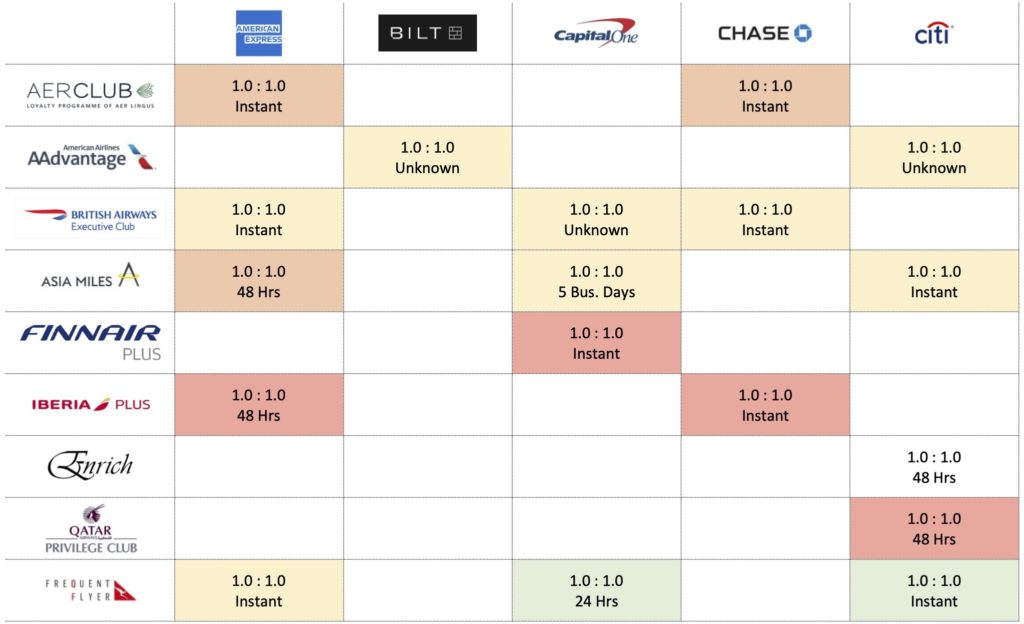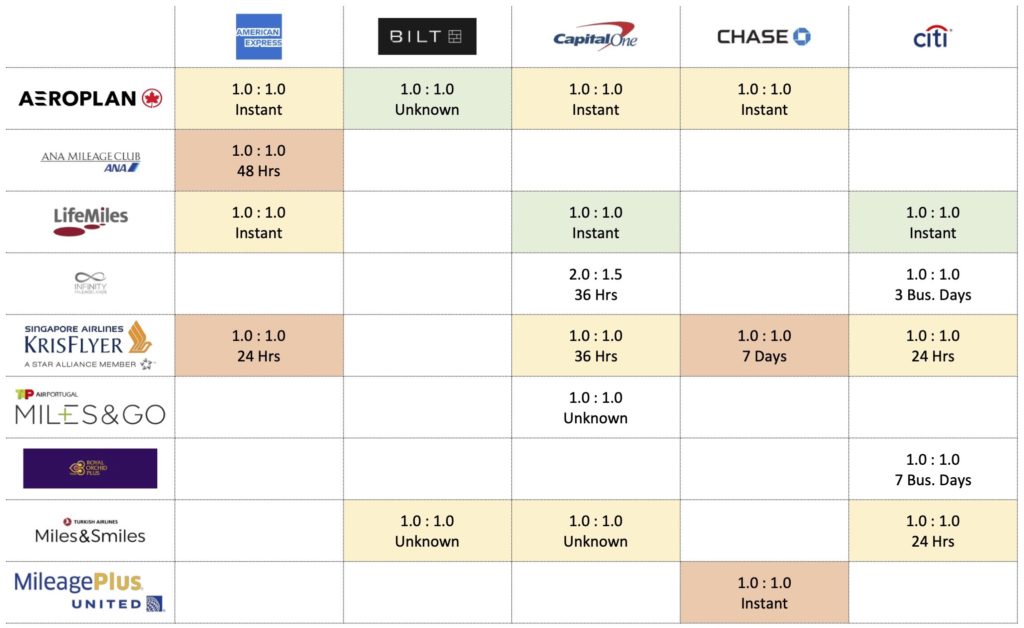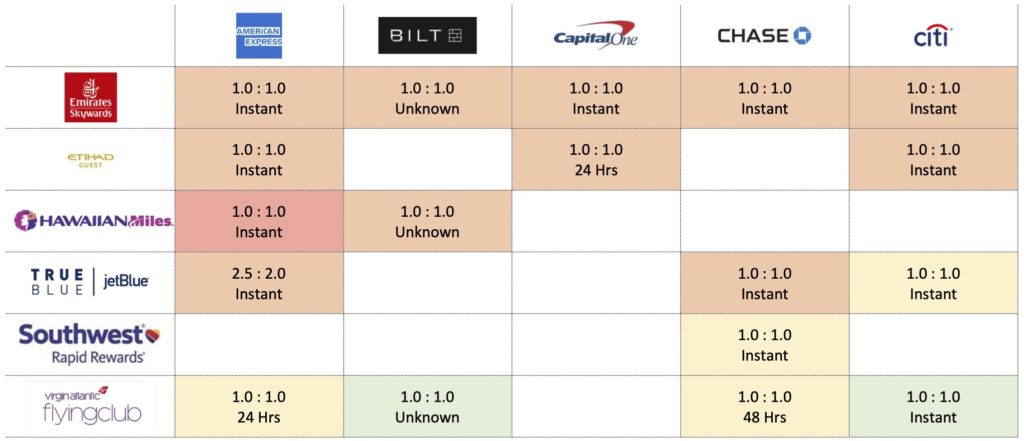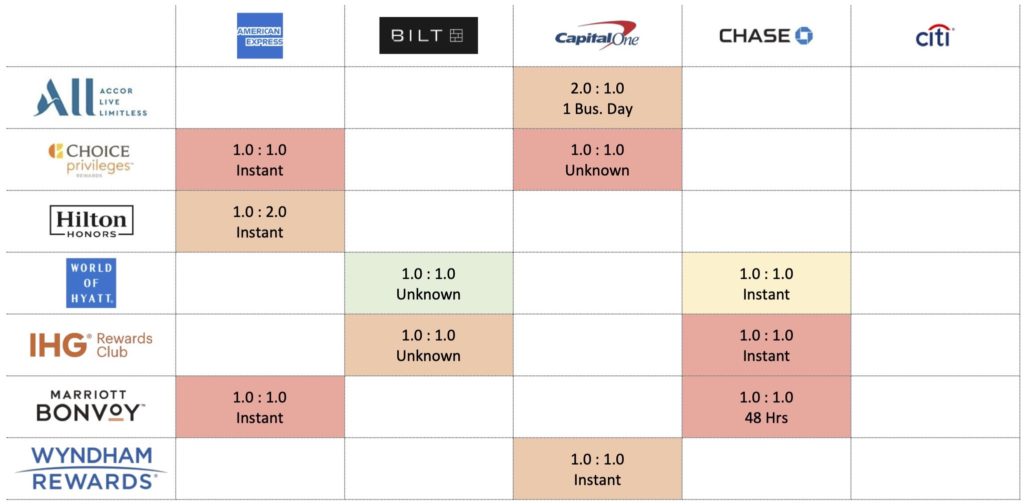There are two sides to the points and miles coin: earning and redeeming. In a similar fashion, there are two types of earning and redeeming options: co-branded and branded. With co-branded travel rewards, the limit for both earning and redeeming opportunities is to a single brand (i.e. Hilton, Marriott, Delta, Southwest, etc.). You can only use your points and miles for that specific brand. However, branded travel rewards (i.e. Chase, AMEX, Citi, etc.) provide earning and redeeming opportunities in a flexible points currency. A flexible points currency opens up multiple options to redeem points and miles through transfers.
What Is A Credit Card Point Transfer

With some travel rewards programs, you have the option to transfer the points you earn through every day spending to either an airline or hotel partner. Each bank has its own, unique, rewards currency and partner program(s); as well as unique rules and regulations governing the points transfer. The major transferable point currencies are:
AMEX Membership Rewards (MR)
BILT Rewards
Capital One Miles
Chase Ultimate Rewards (UR)
Citi ThankYou Rewards
A point transfer occurs at the moment you agree to transfer your points from one of the flexible point currencies to a specific airline or hotel program. Each point transfer has a particular transfer ratio (i.e. 1:1, 2:1, etc.) and usually transacts in lots of 1,000 points (i.e. no transferring 591 points). The transfer operates as a “one-way door.” Once the transfer is complete, reversing the transfer is not possible.
What Are Example Credit Card Point Transfers
Airlines

The transfer options between flexible point currencies and airlines are numerous; roughly 28 transfer partners exist. The optionality airline transfer partners provide, creates significant value, but also allows for potentially poor transfers. Here is a summary of the major airline alliance transfer options and potential value (Green = Great Value; Yellow = Average Value; Orange = Poor Value; and Red = Terrible Value).
Oneworld
Oneworld is the smallest of the three major, global, airline alliances. The alliance consists of 14 member airlines offering 1,000 destinations in more than 170 countries. Oneworld currently offers 9 transfer partner options across the major flexible point currencies; tied with Star Alliance for the most transfer partners.

SkyTeam
SkyTeam is the second largest of the three major, global, airline alliances. The alliance consists of 19 member airlines offering 1,036 destinations in more than 170 countries. SkyTeam currently offers 4 transfer partner options across the major flexible point currencies; by far the fewest. On October 15th, 2021, this number drops to 3 with Alitalia ceasing operations.

Star Alliance
Star Alliance is the largest of the three major, global, airline alliances. The alliance consists of 26 member airlines offering 1,300 destinations in more than 170 countries. Star Alliance currently offers 9 transfer partner options across the major flexible point currencies; tied with Oneworld for the most transfer partners.

Other Airlines
In addition to the major airline alliances, a number of airlines operate independently; although often with multiple codeshare agreements. Currently, 6 airline transfer options exist beyond the major alliances.

There are only two airlines – Air France / KLM and Emirates – where you can transfer points from every major travel rewards credit card provider. Conversely, there are nine airlines – ANA, Delta, Finnair, Malaysian, Qatar, Southwest, TAP, Thai, and United – where you can only transfer points from a single major travel rewards credit card provider.
Hotels

The hotel point redemption landscape differs significantly from that of airlines. The most obvious difference is fewer transfer options. The major hotel brands have a larger global footprint, versus airlines, which limits the need for multiple partners. In addition, hotel transfer options operate more on a 1:1 scale. There is no hotel program which offers transfer options across all major travel rewards credit card issuers. Here is a summary of the hotel transfer options and potential value (Green = Great Value; Yellow = Average Value; Orange = Poor Value; and Red = Terrible Value).

Why Are Credit Card Point Transfers Important?
The ability to transfer credit card points to a variety of airlines and hotels provides flexibility and optionality in point redemption. However, not all point transfers are equal; good and bad transfers do exist. As a general statement, the most valuable point transfers exist between flexible point currencies and airlines; but again, this does not apply to every airline. While maximizing points and miles earning is important, maximizing the redemption value is just as important. In addition, flexible point currencies provide a “hedge” against individual airline and hotel award program devaluations.
When To Initiate A Credit Card Point Transfer
Given the “one way door” nature of a points transfer, knowing when to transfer is important. There are three common scenarios where a points transfer makes sense:
- When the redemption value of a point transfer to a specific airline or hotel exceeds the value of using the points directly via a respective travel portal; i.e. Chase Travel Portal for Chase Ultimate Rewards, AMEX Travel for AMEX Membership Rewards, etc.
- When there is a known travel requirement in the immediate or near future.
- When there is a risk of points and miles expiration due to inactivity.
What Are The Challenges With Credit Card Point Transfers

The most significant challenge with a points transfer is the “one way door” nature of the transfer itself. Once you make the transfer, there is no “undo” or “reverse” button. The transfer is final. Another issue, which often catches people off guard, is the potential lag between a transfer initiation and transfer completion. While most point transfers occur instantly, there are some which take days or even a full week. In these scenarios, the risk is the loss of an award ticket availability. An award ticket available on Monday may not still be there on Friday.
Final Thoughts
Flexible point currencies are the most valuable asset in the world of travel rewards. Understanding the transfer partner landscape helps shape your travel rewards strategy. In general, a transfer from a flexible point currency to an airline is more valuable than to a hotel. Within the transfers themselves, many transfer partners allow transfers from more than one flexible points currency. However, there are multiple transfer partners which only allow transfers from a single flexible points currency. As a final note, once you transfer the points to a given airline or hotel, they all have the same value!
